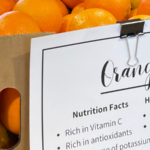3 Minute Read
What Kids Eat Makes A Difference
Before entering the stages of puberty, growth and development make up the childhood years. Though children at this stage are progressing slower compared to their toddler years, they develop a lot physically, intellectually, emotionally, and socially.
For proper development to happen, we need to support a child with good nutrition to make sure that they don’t fall behind on the CDC growth chart, but while not having them get too far ahead in the overweight and obesity percentiles.

Growing & Moving
It is common for school-aged children to match how much they eat with their growth patterns. Remember this simple equation:
Growth spurt = more calories needed to grow at a healthy rate.
This also relates to their daily level of physical activity. Ideally, in this stage of life, the body is storing nutrients for puberty and the rapid development during adolescence so providing as many healthy choices as possible will support the health and growth of a child.
What About Arkansan Kids?
Yet, in 2019 alone Arkansas was in the top 10 states with the greatest number of obese children. Yet Arkansas is also in the top 10 states with the greatest food-insecure households.
How can a child be obese yet face food insecurity at the same time?
Food-Insecure Defined

Being food-insecure doesn’t mean being hungry.
It’s possible that there could be hunger in the household. Most of the time, however, the most food-insecure households live in communities that don’t have access to grocery stores or other living expenses are high that they cannot afford healthy food.
This results in a higher intake of energy-dense foods to make sure that children don’t go hungry.
Energy-Dense Foods: higher in calories and more processed
Impact of Food Insecurity on Children
As a result, children who eat poorly are likely to develop long-term health problems.
- Impaired growth
- Cavities
- Poor memory
- Lack of cognitive skills
- Falling behind in school
- Irregularity of blood sugar.
What Well Fed Is Doing About It
The good news is there is hope for families facing food insecurity who take part in the Well Fed program!
The foods offered at Well Fed’s mobile markets or in food boxes can support the healthy development of a child.
The top 5 essential nutrients a child needs to grow and develop properly are:
- protein
- iron
- vitamin D
- calcium
- omega-3s.

What We Provide (For Free!)
Common foods we include in a market are eggs, tuna, broccoli, sweet potatoes, collard greens, and great northern beans. These foods can especially support a child’s growth.
Former CEO of Xerox, Anne M. Mulcahy said,
“Investing in early childhood nutrition is a surefire strategy. The returns are incredibly high.”
Supporting healthy growth and development now will reap the benefits of this generation’s future. Well Fed’s mission and vision ensure that children will be set up for success and live a long and healthy life with a reduced risk of chronic diseases!
Article by Anna Polo, Dietetic Intern
Unsplash / Mieke Campbell & Element5 Digital
Sign up for our newsletter to see more content like this
Subscribe





































